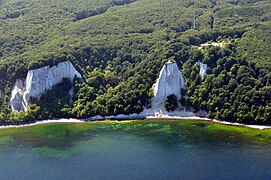Königsstuhl (Ruegen)
| King's chair | ||
|---|---|---|
|
The Königsstuhl - seen from the Victoria viewpoint |
||
| height | 118 m above sea level NN | |
| location | Ruegen , Mecklenburg-Western Pomerania , Germany | |
| Coordinates | 54 ° 34 '23 " N , 13 ° 39' 45" E | |
|
|
||
| rock | chalk | |
The Königsstuhl is the most famous chalk cliff formation in the Stubbenkammer in the Jasmund National Park on the island of Rügen . Its height is 118 m above sea level. NN .
geography
location
The Königsstuhl is located 7 km north of Sassnitz and 4 km southeast of Lohme . The national park center can be reached by shuttle bus from the large car park in Hagen (district of the municipality of Lohme), which is 3 km away, via a 11 km long high bank path that leads from Sassnitz to Lohme . Entrance to the center and thus access to the Königsstuhl itself is subject to a fee. The Königsstuhl on Rügen is a tourist magnet. Around 300,000 visitors come to the Königsstuhl every year to enjoy the view of the Baltic Sea and the chalk cliffs. However, the access via the so-called royal grave is becoming increasingly narrow due to rock breaks. The city of Sassnitz is therefore planning a new viewing platform.
The Königstuhl area is also easily accessible by bike, e.g. B. on the Baltic Sea Cycle Route .
geology
Rügen chalk is the name for a very pure, very fine-grained, white, friable and highly porous limestone of the highest Upper Cretaceous ( Maastrichtian ). He is among others in the cliff of Jasmund in the northeast of the island of Ruegen minded - "white cliffs". Geologically, the Rügen chalk belongs to the Hemmoor formation of the writing chalk group and is referred to there as a Rügen member . Chronostratigraphically , the Rügen member falls into the late lower to the late upper Lower Maastricht - about 70 million years ago . In the northeastern part of the island of Rügen, on the Jasmund peninsula, there are extensive chalk deposits. The best known are the "Rügen chalk cliffs" on the cliff coast in the vicinity of Sassnitz. These coastal formations are part of the Jasmund National Park and are under strict nature protection.
Personality, name and story
The narrow, but massive granite steps that lead to the 200 m² plateau on the Königsstuhl lie over a Bronze Age barrow (2200 to 800 BC). The plateau offers a sweeping view of the Baltic Sea. The Königsstuhl itself is better viewed from the Victoria viewpoint to the south.
The chalk cliff and the neighboring formations drop almost perpendicular to the beach. Due to the geological composition, the groundwater and surface water as well as the waves at the foot of the cliff, there are always smaller and larger breaks on the entire cliff, including the rock formations. Examples of this are the Wissower Klinken known from a painting by CD Friedrich , which no longer exist.
The name Königsstuhl is said to be traced back to an event in 1715 in which the Swedish King Karl XII. is said to have led a naval battle against the Danes from this point . The battle allegedly tired the ruler so much that he had a chair brought to him.
However, the name "Konigsstuel" was used in a travel report by Pastor Rhenan, who was commissioned by the Duke of Pomerania to find mineral springs, so that the name was given much earlier.
According to another legend, the name is said to come from the fact that in ancient times he was elected king who was the first to climb the chalk cliffs from the seaside and sit on the chair above.
There is a similar formation on the Danish island of Møn , the “ Dronningestolen ” = queen's chair.
A similar formation, the “Little King's Chair”, is located in the abandoned Gummanz chalk quarry near the local chalk museum.
Not far south of the Königsstuhl down to the beach, a wooden staircase with 412 steps has led past the old pump house (monument) since ancient times. It was extensively renewed in 1996 and constantly maintained. However, since 2016 it has been closed due to the risk of further demolitions on the chalk coast and should no longer be renewed.
Web links
Individual evidence
- ^ Tourismusverband Mecklenburg-Vorpommern eV: Baltic Sea Cycle Route . In: Tourismusverband Mecklenburg-Vorpommern eV ( auf-nach-mv.de [accessed on May 11, 2017]).
- ↑ Julius von Bohlen : Report of M. Johann Rhenan, pastor and princely Saltzgrauen zu Soeden near Allendorff in Hesse about his travels through Vor-Pommern and Rügen in 1584 . In: Pommersches Jahrbuch for history and antiquity research as well as for statistics and scientific discussion of social issues, 2nd year 1868, Stralsund 1869, pp. 57-73 ( digitized version )
- ^ Heinz Lehmann, Renate Meyer: Rügen A – Z (Arkona - Zudar). Wähmann-Verlag, Schwerin 1976, p. 44
- ↑ Article Minister: No new stairs at the Königsstuhl - the decision to descend Rügen's landmark was made in a consultation between the Environment Minister and municipalities, offices and citizens' initiative in the Ostsee-Zeitung on February 13, 2018





